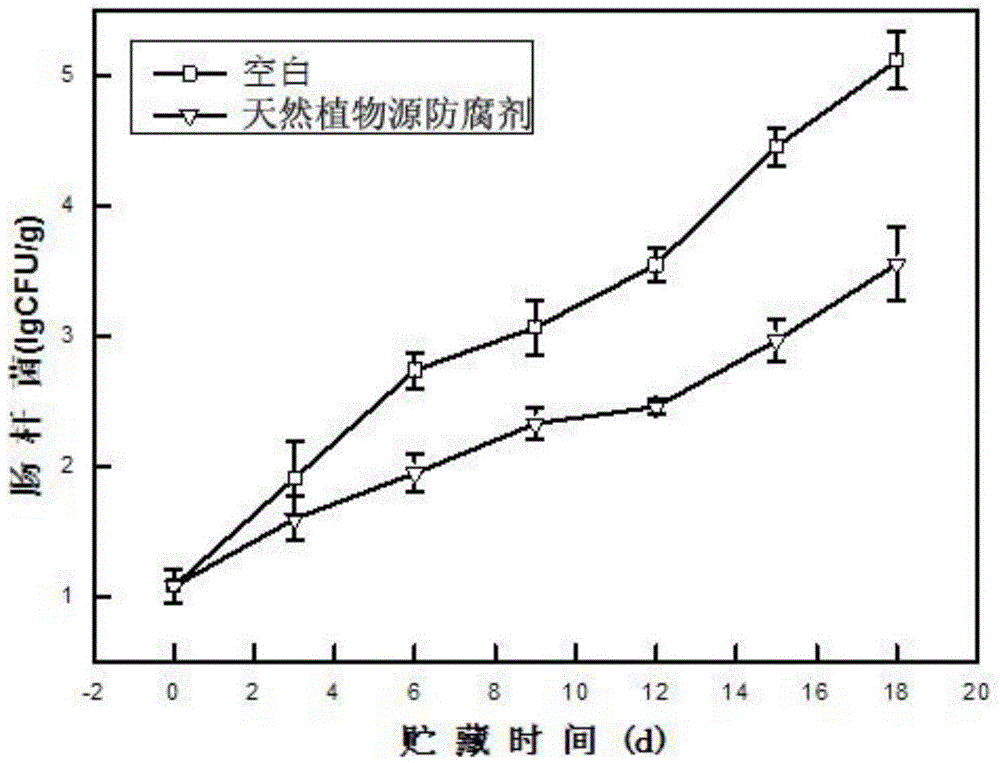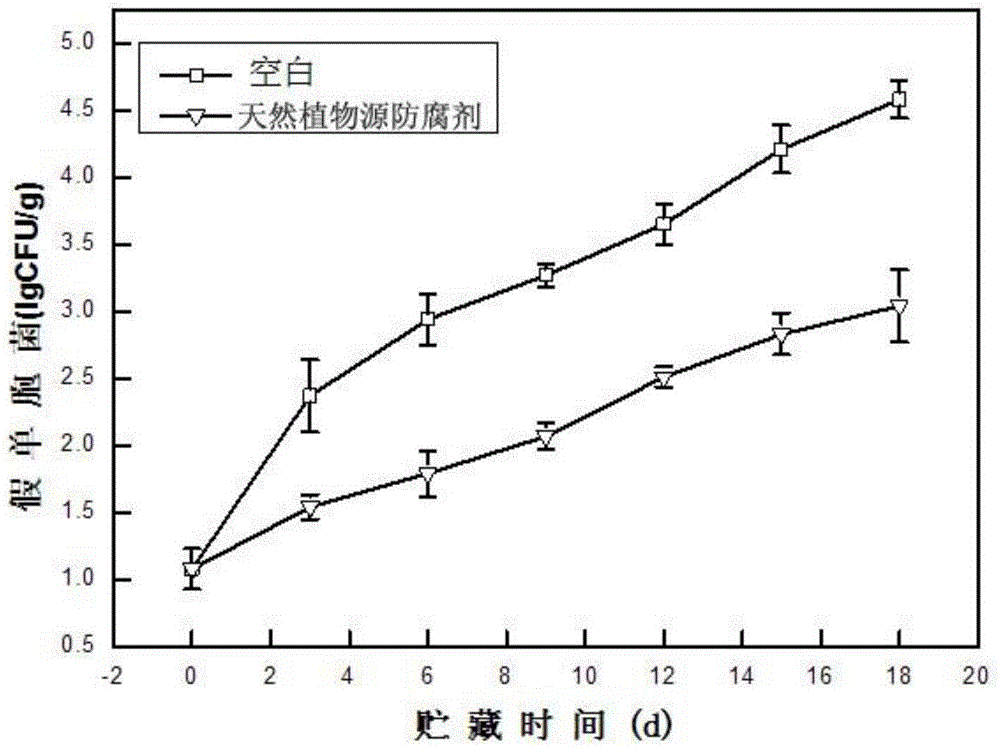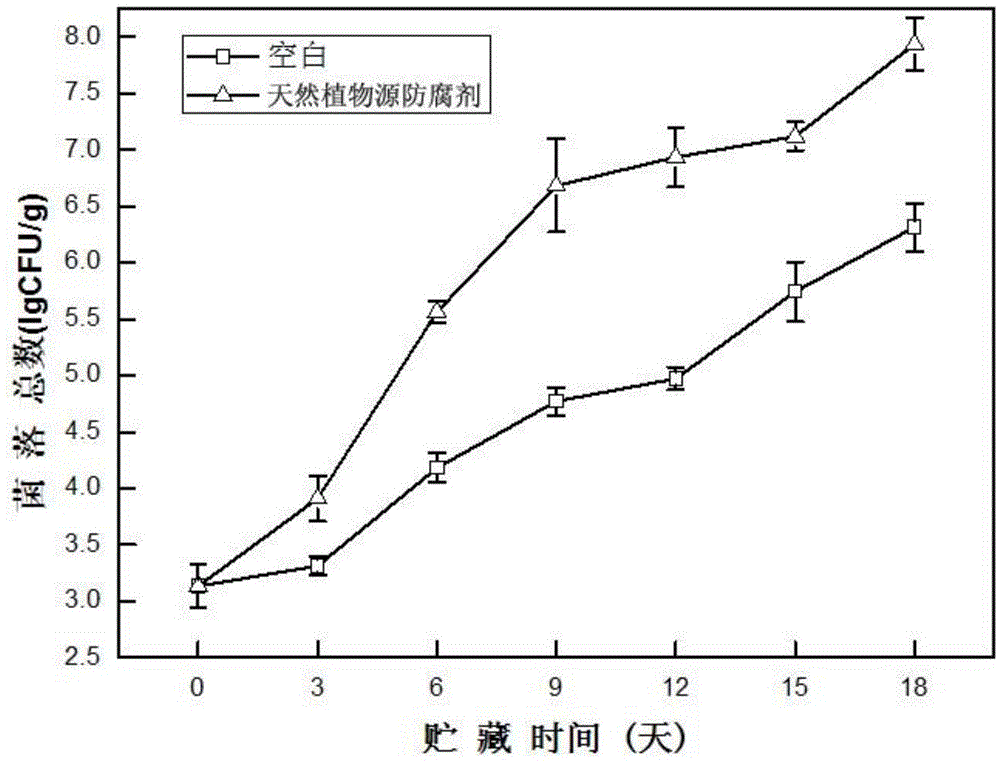Natural plant-derived antiseptic and its preparation method and use
A technology of natural plants and preservatives, applied in the fields of application, food science, food preservation, etc., to achieve the effect of prolonging the shelf life, simplifying the preparation process, and maintaining color and flavor
- Summary
- Abstract
- Description
- Claims
- Application Information
AI Technical Summary
Problems solved by technology
Method used
Image
Examples
Embodiment 1
[0020] Wash and drain the fresh G. chinensis leaves, put them in a constant temperature drying oven at 70°C for 36 hours, crush them after cooling, and pass through a 40-mesh sieve to obtain G. syringae powder; take an appropriate amount of G. For Tiankui powder, add 70% ethanol according to the ratio of solid to liquid at 1:30, reflux extraction at 70°C for 1.5 hours, suction filtration, and repeat extraction of the residue twice. The filtrates were combined, concentrated by rotary evaporation at 60°C, and freeze-dried to obtain the extract of G. violet.
[0021] Take fresh citrus peel, dry it at 70°C for 36 hours, crush it after cooling, and pass through 40 sieves to get citrus peel powder; take an appropriate amount of citrus peel powder, add 80% ethanol according to the ratio of solid to liquid 1:5, and extract under reflux at 70°C. The reflux time was 1 h, suction filtration, the residue was extracted twice, the filtrates were combined, concentrated by rotary evaporation ...
Embodiment 2
[0024] Wash and drain fresh leaves of G. chinensis, put them in a constant temperature drying oven at 80°C for 48 hours, crush them after cooling, and pass through a 60-mesh sieve to obtain G. syringae powder; For tiankui powder, add 80% ethanol according to the ratio of solid to liquid at 1:20, extract under reflux at 60°C for 2 hours, filter with suction, and extract the residue twice. The filtrates were combined, concentrated by rotary evaporation at 70° C., and freeze-dried to obtain the extract of G. chinensis.
[0025] Take fresh citrus peels, dry them at 80°C for 24 hours, crush them after cooling, pass through 60 sieves to get citrus peel powders; take an appropriate amount of citrus peel powders, add 90% ethanol according to the ratio of solid to liquid 1:7, and extract under reflux at 70°C. The reflux time was 1.5 h, suction filtration, the residue was extracted twice, the filtrates were combined, concentrated by rotary evaporation at 70°C, and freeze-dried to obtain...
Embodiment 3
[0028] Wash and drain the fresh leaves of G. chinensis, put them in a constant temperature drying oven at 75°C for 24 hours, crush them after cooling, and pass through a 40-mesh sieve to obtain G. syringae powder; For geranium powder, add 75% ethanol at a ratio of 1:25 to solid, extract at 65°C under reflux for 1.7 hours, filter with suction, and extract the residue twice. The filtrates were combined, concentrated by rotary evaporation at 65° C., and freeze-dried to obtain the extract of G. chinensis.
[0029] Take fresh citrus peel, dry it at 75°C for 48 hours, crush it after cooling, and pass through 40 sieves to obtain citrus peel powder; take an appropriate amount of citrus peel powder, add 80% ethanol according to the ratio of material to liquid 1:10, and extract under reflux at 65°C. The reflux time was 1.3 h, suction filtration, the residue was extracted twice, the filtrates were combined, concentrated by rotary evaporation at 65°C, and freeze-dried to obtain orange pee...
PUM
 Login to View More
Login to View More Abstract
Description
Claims
Application Information
 Login to View More
Login to View More - R&D
- Intellectual Property
- Life Sciences
- Materials
- Tech Scout
- Unparalleled Data Quality
- Higher Quality Content
- 60% Fewer Hallucinations
Browse by: Latest US Patents, China's latest patents, Technical Efficacy Thesaurus, Application Domain, Technology Topic, Popular Technical Reports.
© 2025 PatSnap. All rights reserved.Legal|Privacy policy|Modern Slavery Act Transparency Statement|Sitemap|About US| Contact US: help@patsnap.com



